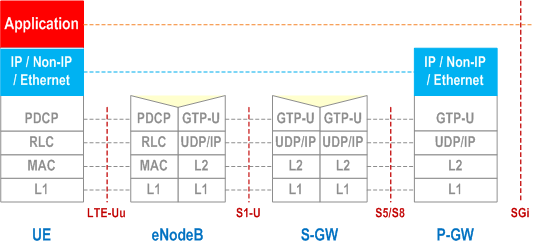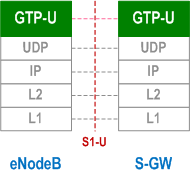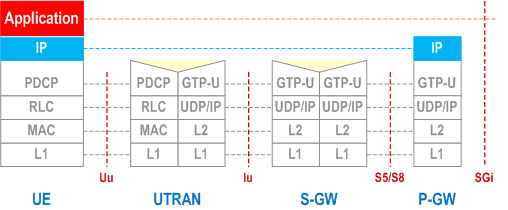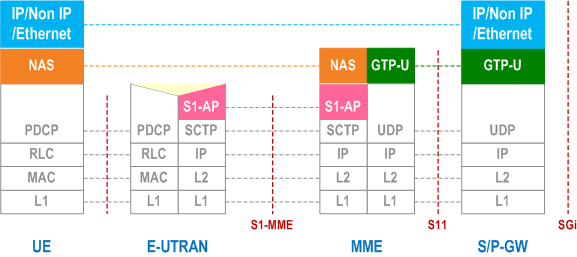Content for TS 23.401 Word version: 19.1.0
1…
4…
4.2.2…
4.3…
4.3.6…
4.3.8…
4.3.12…
4.3.16…
4.3.20…
4.3.25…
4.4…
4.6…
4.7…
4.13…
5…
5.1.2…
5.3…
5.3.2…
5.3.3…
5.3.3.2
5.3.3.3…
5.3.4…
5.3.4B…
5.3.5…
5.3.8…
5.3.9…
5.4…
5.4.4…
5.5…
5.5.1.2…
5.5.2…
5.5.2.2…
5.5.2.3…
5.5.2.4…
5.6…
5.7.3…
5.7A…
5.10
5.11…
5.19…
D…
D.3…
D.3.4
D.3.5
D.3.6
D.3.7…
D.3.8…
E
F…
J…
K…
L…
M…
O…
5.1.2 User Plane
5.2 Identities
5.2.1 EPS bearer identity
5.2.2 Globally Unique Temporary UE Identity
5.2.3 Tracking Area Identity (TAI)
5.2.4 eNodeB S1-AP UE Identity (eNodeB S1-AP UE ID)
5.2.5 MME S1-AP UE Identity (MME S1-AP UE ID)
5.2.6 Closed Subscriber Group ID
5.2.7 UE Radio Capability ID
...
...
5.1.2 User Plane p. 135
5.1.2.1 UE - P-GW user plane with E-UTRAN p. 135

Legend:
- GPRS Tunnelling Protocol for the user plane (GTP-U): This protocol tunnels user data between eNodeB and the S-GW as well as between the S-GW and the P-GW in the backbone network. GTP shall encapsulate all end user packets. End user Ethernet packets are only used with a combined PDN-GW+SMF (as specified in TS 23.501).
- MME controls the user plane tunnel establishment and establishes User Plane Bearers between eNodeB and S-GW.
- UDP/IP: These are the backbone network protocols used for routing user data and control signalling.
- LTE-Uu: The radio protocols of E-UTRAN between the UE and the eNodeB are specified in TS 36.300.
5.1.2.2 eNodeB - S-GW p. 135

Legend:
- GPRS Tunnelling Protocol for the user plane (GTP-U): This protocol tunnels user data between eNodeB and S-GW.
- User Datagram Protocol (UDP): This protocol transfers user data. UDP is defined in RFC 768.
5.1.2.3 UE - PDN-GW user plane with 2G access via the S4 interface p. 136

Legend:
- GPRS Tunnelling Protocol for the user plane (GTP-U): This protocol tunnels user data between SGSN and the S-GW as well as between the S-GW and the P-GW in the backbone network. GTP shall encapsulate all end user IP packets.
- UDP/IP: These are the backbone network protocols used for routing user data and control signalling.
- Protocols on the Um and the Gb interfaces are described in TS 23.060.
5.1.2.4 UE - PDN-GW user plane with 3G access via the S12 interface p. 137

Legend:
- GPRS Tunnelling Protocol for the user plane (GTP-U): This protocol tunnels user data between UTRAN and the S-GW as well as between the S-GW and the P-GW in the backbone network. GTP shall encapsulate all end user IP packets.
- UDP/IP: These are the backbone network protocols used for routing user data and control signalling.
- Protocols on the Uu interface are described in TS 23.060.
- SGSN controls the user plane tunnel establishment and establish a Direct Tunnel between UTRAN and S-GW as shown in Figure 5.1.2.4-1.
5.1.2.5 UE - PDN-GW user plane with 3G access via the S4 interface p. 138

Legend:
- GPRS Tunnelling Protocol for the user plane (GTP-U): This protocol tunnels user data between UTRAN and the SGSN, between SGSN and S-GW as well as between the S-GW and the P-GW in the backbone network. GTP shall encapsulate all end user IP packets.
- UDP/IP: These are the backbone network protocols used for routing user data and control signalling.
- Protocols on the Uu and the Iu interfaces are described in TS 23.060.
- SGSN controls the user plane tunnel establishment and establishes a tunnel between SGSN and S-GW. If Direct Tunnel is established between UTRAN and S-GW, see Figure 5.1.2.4-1.
5.1.2.6 UE - P-GW user plane with Control Plane CIoT EPS Optimisations |R13| p. 139

Legend:
- GTP-u (GPRS Tunnelling Protocol User plane): This protocol tunnels user data between MME and the S-GW as well as between the S-GW and the P-GW in the backbone network. GTP shall encapsulate all end user packets. End user Ethernet packets are only used with a combined PDN-GW+SMF (as specified in TS 23.501).
- UDP/IP: These are the backbone network protocols used for routing user data and control signalling.
- NAS: this is the Non-Access Stratum Layer used to carry Data between UE and MME and may include Header compression and security functions of user plane IP data. Whether a convergence protocol sublayer may be required for this purpose is a stage 3 matter.
5.2 Identities p. 139
5.2.1 EPS bearer identity p. 139
An EPS bearer identity uniquely identifies an EPS bearer for one UE accessing via E-UTRAN. The EPS Bearer Identity is allocated by the MME. When using an EPS Radio Bearer, there is a one to one mapping between EPS RB and EPS Bearer, and the mapping between EPS RB Identity and EPS Bearer Identity is made by E-UTRAN. The E-RAB ID value used at S1 and X2 interfaces to identify an E-RAB is the same as the EPS Bearer ID value used to identify the associated EPS Bearer. When using Control Plane CIoT EPS Optimisation for user data transport for the PDN connectivity service, the MME (for uplink) and UE (for downlink) uses the EPS Bearer Identity contained within the NAS PDUs to identify the associated EPS bearer.
When there is a mapping between an EPS bearer and a PDP context, the same identity value is used for the EPS bearer ID and the NSAPI/RAB ID.
In some SM signalling messages in GERAN/UTRAN, transaction identifier (TI) represents NSAPI. The TI is dynamically allocated by the UE for UE-requested PDP context activation, and by the network for network-requested PDP context activation. A corresponding allocation is also needed for EPS Bearers in order to successfully transfer Bearers to GERAN/UTRAN. The TI is deallocated when a PDP context/EPS Bearer has been deactivated. TI usage is defined in TS 23.060.
5.2.2 Globally Unique Temporary UE Identity p. 139
The MME shall allocate a Globally Unique Temporary Identity (GUTI) to the UE. The GUTI is defined in TS 23.003.
5.2.3 Tracking Area Identity (TAI) p. 140
This is the identity used to identify tracking areas. The Tracking Area Identity is constructed from the MCC (Mobile Country Code), MNC (Mobile Network Code) and TAC (Tracking Area Code).
A TAI should be associated with a single time zone. All TAIs served by one eNodeB shall be in the same time zone.
5.2.4 eNodeB S1-AP UE Identity (eNodeB S1-AP UE ID) p. 140
This is the temporary identity used to identify a UE on the S1-MME reference point within the eNodeB. It is unique within the eNodeB.
5.2.5 MME S1-AP UE Identity (MME S1-AP UE ID) p. 140
This is the temporary identity used to identify a UE on the S1-MME reference point within the MME. It is unique within the MME.
5.2.6 Closed Subscriber Group ID |R9| p. 140
A CSG ID is a unique identifier within the scope of PLMN defined in TS 23.003 which identifies a Closed Subscriber Group (CSG) in the PLMN associated with a CSG cell or group of CSG cells.
5.2.7 UE Radio Capability ID |R16| p. 140
The UE Radio Capability ID is a short pointer with format defined in TS 23.003 that is used to uniquely identify a set of UE Radio Capabilities (excluding UTRAN and NB-IoT capabilities). The UE Radio Capability ID is assigned either by the serving PLMN or by the UE manufacturer, as follows:
- UE manufacturer-assigned: The UE Radio Capability ID may be assigned by the UE manufacturer in which case it includes the UE manufacturer information (i.e. a Vendor ID). In this case, the UE Radio Capability ID uniquely identifies a set of UE radio capabilities and the UE Radio Capability for Paging for this manufacturer in any PLMN.
- PLMN-assigned: If a UE manufacturer-assigned UE Radio Capability ID is not used by the UE or the serving network, or it is not recognised by the serving PLMN UCMF, the UCMF may allocate UE Radio Capability IDs for the UE corresponding to different sets of UE radio capabilities the PLMN may receive from the UE at different times. In this case, the UE Radio Capability IDs the UE receives are applicable to the serving PLMN and uniquely identify the corresponding sets of UE radio capabilities and the UE Radio Capability for Paging(s) in this PLMN. The PLMN assigned UE Radio Capability ID includes a Version ID in its format. The value of the Version ID is the one configured in the UCMF, at time the UE Radio Capability ID value is assigned. The Version ID value makes it possible to detect whether a UE Radio Capability ID is current or outdated.